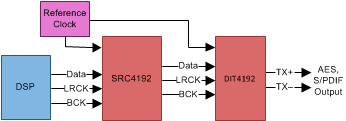SBFS022C June 2003 – October 2015 SRC4192 , SRC4193
PRODUCTION DATA.
- 1 Features
- 2 Applications
- 3 Description
- 4 Revision History
- 5 Pin Configuration and Functions
- 6 Specifications
- 7 Detailed Description
- 8 Application and Implementation
- 9 Power Supply Recommendations
- 10Layout
- 11Device and Documentation Support
- 12Mechanical, Packaging, and Orderable Information
Package Options
Refer to the PDF data sheet for device specific package drawings
Mechanical Data (Package|Pins)
- DB|28
Thermal pad, mechanical data (Package|Pins)
Orderable Information
1 Features
- Automatic Sensing of the Input-to-Output Sampling Ratio
- Wide Input-to-Output Sampling Range: 16:1 to 1:16
- Supports Input and Output Sampling Rates Up to 212 kHz
- Dynamic Range: 144 dB (–60-dbFS Input, BW = 20 Hz to fS/2, A-Weighted)
- THD+N: –140 dB (0-dbFS Input, BW = 20 Hz to fS/2)
- Attenuates Sampling and Reference Clock Jitter
- High-Performance, Linear-Phase Digital Filtering with Stop Band Attenuation Greater than 140 dB
- Flexible Audio Serial Ports:
- Master or Slave-Mode Operation
- Supports I2S, Left-Justified, Right-Justified, and TDM Data Formats
- Supports 16, 18, 20, or 24-Bit Audio Data
- TDM Mode Allows Daisy-Chaining of up to Eight Devices
- Supports 24-, 20-, 18-, or 16-Bit Input and Output Data: All Output Data is Dithered from the Internal 28-Bit Data Path
- Low Group Delay Option for Interpolation Filter
- Direct Downsampling Option for Decimation Filter (SRC4193 Only)
- SPI Port Provides Access to Internal Control Registers (SRC4193 Only)
- Soft Mute Function
- Bypass Mode
- Programmable Digital Output Attenuation (SRC4193 Only); 256 Steps: 0 dB to –127.5 dB, 0.5-dB/step
- Power Down Mode
- Operates From a Single 3.3-V Power Supply
- Small 28-Pin SSOP Package
- Pin Compatible with the AD1896 (SRC4192 Only)
2 Applications
- Digital Mixing Consoles
- Digital Audio Workstations
- Audio Distribution Systems
- Broadcast Studio Equipment
- High-End A/V Receivers
- General Digital Audio Processing
3 Description
The SRC4192 and SRC4193 devices are asynchronous, sample-rate converters designed for professional and broadcast audio applications. The SRC4192 and SRC4193 devices combine a wide input-to-output sampling ratio with outstanding dynamic range and ultra-low distortion. Input and output serial ports support standard audio formats, as well as a Time Division Multiplexed (TDM) mode. Flexible audio interfaces allow the SRC4192 and SRC4193 devices to connect to a wide range of audio data converters, digital audio receivers and transmitters, and digital signal processors.
The SRC4192 device is a standalone, pin-programmed device, with control pins for mode, data format, mute, bypass, and low group-delay functions. The SRC4193 device is a software-controlled device featuring a serial peripheral interface (SPI) port, which is utilized to program all functions through the internal control registers.
The SRC4192 and SRC4193 devices can operate from a single 3.3-V power supply. A separate digital I/O supply (VIO) operates over the 1.65-V to 3.6-V supply range, allowing greater flexibility when interfacing to current and future generation signal processors and logic devices. Both devices are available in a 28-pin SSOP package.
Device Information(1)
| PART NUMBER | PACKAGE | BODY SIZE (NOM) |
|---|---|---|
| SRC4192 | SSOP (28) | 5.30 mm × 10.20 mm |
| SRC4193 |
- For all available packages, see the orderable addendum at the end of the data sheet.
Simplified Application Diagram

4 Revision History
Changes from B Revision (September 2007) to C Revision
- Added ESD Ratings table, Feature Description section, Device Functional Modes, Application and Implementation section, Power Supply Recommendations section, Layout section, Device and Documentation Support section, and Mechanical, Packaging, and Orderable Information section.Go
Changes from A Revision (July 2003) to B Revision
- Added U.S. patent number to note (1) U.S. Patent No. 7,262,716. Go